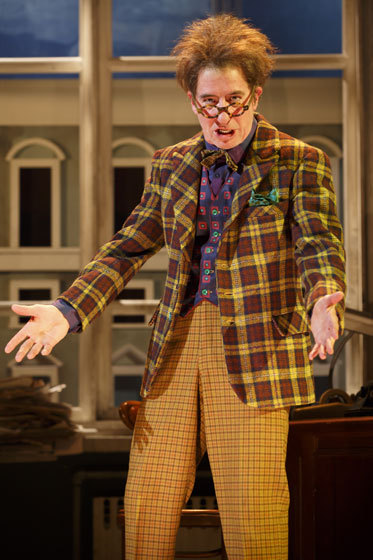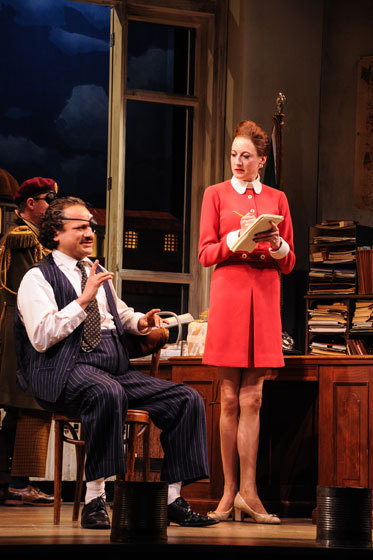The mind works in mysterious ways. During one week I had some bizarre experiences in dreamland that covered sights and sounds quite different from past adventures.
In several of these dreams I found myself in the basement level of an old department store that was undergoing a makeover in order to appeal to a new generation of consumers. Although the floor plan (and much of the furniture) was dominated by right angles, there were no guarantees of permanence.
People might wander across my line of vision who seemed familiar from past dreams (and certainly seemed to recognize me) but they turned out to be actors dressed as Neanderthals, who had been tasked with demonstrating how consumers could buy and use a collection of lawn furniture to help camouflage a sinkhole that had developed in their back yard. At the touch of a button, the floor promptly caved in.
At other times I found myself obsessing over audiotapes I needed to return to a group of court reporters after I had finished transcribing their depositions. But it didn't seem like the lobby to their building was the way I had remembered it (had I ever really been there, anyway?). Attaché cases briefly appeared and then vanished while filled with my possessions. Entire retail displays disappeared as soon as I passed by.
I don't doubt that some of these dreams were triggered by a series of Canadian animation shorts I had watched from a program at CAAMFest 2014. However, these shorts also helped to clarify how creativity sometimes works in very messy ways.
What we often see as a final product has been carefully mapped, plotted, and refined to a point where it is monodirectional and aimed to please. Consider the following Ramen Party Music Video (created by Lillian Chan, John Poon, and Michael Mak) as an example:
Lately, I've found myself getting up several times during the night and then, after climbing back into bed, falling back into the same dream sequence I had just emerged from. Or is that what's really going on? David Nguyen's video game-inspired short, Insert Credit, offers a hint of what might be bubbling somewhere in my subconscious.
Nguyen's animation is still quite linear, methodical, and destination driven. By contrast, my dreams tend to be more chaotic, taking me into situations, colors, and dimensions that I could never experience in my waking hours. Perhaps that's why I was intrigued by the Yellow Sticky Notes/Canadian Anijam curated by Jeff Chiba Stearns.
The following two clips illustrate how creativity can come in short (and often messy) spurts of imagination.
* * * * * * * * * *
Sustaining chaos as an engine of stage farce is easier said than done. It requires an awful lot of imagination, determination, a seemingly endless supply of shtick, and a dedicated troupe of clowns with great timing.
The Berkeley Repertory Theatre recently presented a new production of Dario Fo's provocative political farce entitled Accidental Death of an Anarchist (which was first performed in December 1970). Fo's farce was inspired on the 1969 incident in which an Italian railroad worker/anarchist named Giuseppe Pinelli fell to his death (or might have been pushed) from a fourth floor window of a local police station in Milan. In describing the audience's reaction to the first performances of Accidental Death of an Anarchist (when the memory of Pinelli's death and the December 12, 1969 Piazza Fontana bombing was still raw in the public's mind), Fo noted that:
Since its 1970 premiere, Accidental Death of an Anarchist has been translated into numerous languages and performed around the world. While the play provides a dramatic map for the actors, it is essentially a framework which can support all kinds of pratfalls, sight gags, and buffoonery that has kept audiences laughing from the days of the Commedia dell'arte to vaudeville; from Plautus to The Producers. As Berkeley Rep's artistic director, Tony Taccone (who first met the playwright nearly 30 years ago) notes:
![2014-04-03-anarchist1.jpg]()
Stephen Epp stars as the Maniac in Dario Fo's political satire,
Accidental Death of an Anarchist (Photo by: Joan Marcus)
Adapted by Gavin Richards (from a translation by Gillian Hanna) this production has been directed by Christopher Bayes, who has spent many years studying Commedia dell'arte and teaching classes in clown technique. Together with Steven Epp (who stars as the Maniac), the creative team has done its best to pepper the evening with references to current events. Whether citing some of the lost souls who can be found wandering the streets of downtown Berkeley or referencing Senator Dianne Feinstein's criticism of the CIA, every effort is made to keep the audience aware that what they are witnessing onstage is only a tiny part of the corruption and injustice which perverts their daily lives.
![2014-04-03-anarchist2.jpg]()
Eugene Ma, Steven Epp, and Allen Gilmore in a scene from
Accidental Death of an Anarchist (Photo by Joan Marcus)
Among the talented ensemble Bayes has assembled for this co-production with the Yale Repertory Theatre are Liam Craig as the blustering police Superintendent; Renata Friedman as the female journalist, Feletti; Allen Gilmore as the stooge, Pissani; and Jesse J. Perez as the buffoonish investigator, Bertozzo. As a pudgy constable who (when not singing falsetto) is happy to sit on the sidelines eating donuts, Eugene Ma delivers some priceless comedic moments.
How did Bayes find a way to combine the comedic traditions of Commedia dell'arte with cultural references that would resonate with a modern audience? As he explains:
![2014-04-03-anarchist3.jpg]()
Jesse J. Perez and Renata Friedman in a scene from
Accidental Death of an Anarchist (Photo by: Jared Oates)
While Berkeley Rep's production benefits strongly from Kate Noll's unit set and the costumes by Elivia Bovenzi, there were many moments in Act I when I felt as if every possible piece of shtick was being tossed out to the audience in order to see what would stick. As the Maniac, Epp would frequently comment about how the audience was probably wondering why people thought any of this was funny.
However, any discomfort was quelled in Act II when Epp reappeared as a military inspector from another district. Suddenly, the tone of the farce shifted and I found myself watching, in amazement, what felt like a classic Sid Caesar comedy sketch. The sharpness of the satire only served to set the audience up for the sobering dose of reality with which the playwright confronts his audience at the end of the evening.
Whether one tires of the shtick or finds it hysterically funny, there is method to the playwright and director's madness. In addition to Epp's deliciously manic performance, I greatly enjoyed the work of the lanky Renata Friedman and the talented Eugene Ma.
To read more of George Heymont go to My Cultural Landscape
In several of these dreams I found myself in the basement level of an old department store that was undergoing a makeover in order to appeal to a new generation of consumers. Although the floor plan (and much of the furniture) was dominated by right angles, there were no guarantees of permanence.
People might wander across my line of vision who seemed familiar from past dreams (and certainly seemed to recognize me) but they turned out to be actors dressed as Neanderthals, who had been tasked with demonstrating how consumers could buy and use a collection of lawn furniture to help camouflage a sinkhole that had developed in their back yard. At the touch of a button, the floor promptly caved in.
At other times I found myself obsessing over audiotapes I needed to return to a group of court reporters after I had finished transcribing their depositions. But it didn't seem like the lobby to their building was the way I had remembered it (had I ever really been there, anyway?). Attaché cases briefly appeared and then vanished while filled with my possessions. Entire retail displays disappeared as soon as I passed by.
I don't doubt that some of these dreams were triggered by a series of Canadian animation shorts I had watched from a program at CAAMFest 2014. However, these shorts also helped to clarify how creativity sometimes works in very messy ways.
What we often see as a final product has been carefully mapped, plotted, and refined to a point where it is monodirectional and aimed to please. Consider the following Ramen Party Music Video (created by Lillian Chan, John Poon, and Michael Mak) as an example:
Lately, I've found myself getting up several times during the night and then, after climbing back into bed, falling back into the same dream sequence I had just emerged from. Or is that what's really going on? David Nguyen's video game-inspired short, Insert Credit, offers a hint of what might be bubbling somewhere in my subconscious.
Nguyen's animation is still quite linear, methodical, and destination driven. By contrast, my dreams tend to be more chaotic, taking me into situations, colors, and dimensions that I could never experience in my waking hours. Perhaps that's why I was intrigued by the Yellow Sticky Notes/Canadian Anijam curated by Jeff Chiba Stearns.
The following two clips illustrate how creativity can come in short (and often messy) spurts of imagination.
Sustaining chaos as an engine of stage farce is easier said than done. It requires an awful lot of imagination, determination, a seemingly endless supply of shtick, and a dedicated troupe of clowns with great timing.
The Berkeley Repertory Theatre recently presented a new production of Dario Fo's provocative political farce entitled Accidental Death of an Anarchist (which was first performed in December 1970). Fo's farce was inspired on the 1969 incident in which an Italian railroad worker/anarchist named Giuseppe Pinelli fell to his death (or might have been pushed) from a fourth floor window of a local police station in Milan. In describing the audience's reaction to the first performances of Accidental Death of an Anarchist (when the memory of Pinelli's death and the December 12, 1969 Piazza Fontana bombing was still raw in the public's mind), Fo noted that:
The audience split their sides laughing at the effects produced by the comical and at the same time satirical situations. But as the performance went on; they gradually came to see that they were laughing the whole time at real events, events which were criminal and obscene in their brutality; crimes of the state. So the grins froze on their faces and, in most cases, turned into a kind of Grand Guignol scream which had nothing liberating about it, nothing to make things palatable. On the contrary, it made them impossible to swallow.
Since its 1970 premiere, Accidental Death of an Anarchist has been translated into numerous languages and performed around the world. While the play provides a dramatic map for the actors, it is essentially a framework which can support all kinds of pratfalls, sight gags, and buffoonery that has kept audiences laughing from the days of the Commedia dell'arte to vaudeville; from Plautus to The Producers. As Berkeley Rep's artistic director, Tony Taccone (who first met the playwright nearly 30 years ago) notes:
Fo's entire career has been dedicated to the creation of subversive laughter. He has famously taken on politicians, the police, and his personal favorite: the pope. For his efforts he's been vilified and adored, condemned as an outlaw and celebrated as champion of the people. At one point, the State Department labeled him as a dangerous criminal and, for many years, he was barred from entering the United States.
You can read his plays all you want, but they only come alive in performance. They are built around his persona as a professional Fool, a court jester whose job is to expose the hypocrisy of the state and to satirize all forms of corruption. The Fool speaks the truth when no other person dares to; he creates jokes that are based in reality and relentlessly ridicules those who have lied, cheated, or killed to attain power. In that sense, the Fool is a teacher, and the conspiratorial laughter he creates with the audience is both relieving and alarming.

Stephen Epp stars as the Maniac in Dario Fo's political satire,
Accidental Death of an Anarchist (Photo by: Joan Marcus)
Adapted by Gavin Richards (from a translation by Gillian Hanna) this production has been directed by Christopher Bayes, who has spent many years studying Commedia dell'arte and teaching classes in clown technique. Together with Steven Epp (who stars as the Maniac), the creative team has done its best to pepper the evening with references to current events. Whether citing some of the lost souls who can be found wandering the streets of downtown Berkeley or referencing Senator Dianne Feinstein's criticism of the CIA, every effort is made to keep the audience aware that what they are witnessing onstage is only a tiny part of the corruption and injustice which perverts their daily lives.

Eugene Ma, Steven Epp, and Allen Gilmore in a scene from
Accidental Death of an Anarchist (Photo by Joan Marcus)
Among the talented ensemble Bayes has assembled for this co-production with the Yale Repertory Theatre are Liam Craig as the blustering police Superintendent; Renata Friedman as the female journalist, Feletti; Allen Gilmore as the stooge, Pissani; and Jesse J. Perez as the buffoonish investigator, Bertozzo. As a pudgy constable who (when not singing falsetto) is happy to sit on the sidelines eating donuts, Eugene Ma delivers some priceless comedic moments.
How did Bayes find a way to combine the comedic traditions of Commedia dell'arte with cultural references that would resonate with a modern audience? As he explains:
Having grown up in the 1960s and 1970s, Accidental Death of an Anarchist had the kind of sitcom feel like Barney Miller gone terribly wrong, or The Honeymooners, or I Love Lucy gone completely psycho. So we used this feeling as a kind of inspiration for the design elements. It feels very much of its time but also it is very clear that we are doing a period play in the present moment (there is a kind of acknowledgment of the theatrical conceit). Corruption and coverups never seem to stop. They just seem to get stupider because we have grown to expect them. Verbal storytelling tends to be more of a cerebral experience. If a story is told with more physicality, it becomes a more visceral experience.

Jesse J. Perez and Renata Friedman in a scene from
Accidental Death of an Anarchist (Photo by: Jared Oates)
While Berkeley Rep's production benefits strongly from Kate Noll's unit set and the costumes by Elivia Bovenzi, there were many moments in Act I when I felt as if every possible piece of shtick was being tossed out to the audience in order to see what would stick. As the Maniac, Epp would frequently comment about how the audience was probably wondering why people thought any of this was funny.
However, any discomfort was quelled in Act II when Epp reappeared as a military inspector from another district. Suddenly, the tone of the farce shifted and I found myself watching, in amazement, what felt like a classic Sid Caesar comedy sketch. The sharpness of the satire only served to set the audience up for the sobering dose of reality with which the playwright confronts his audience at the end of the evening.
Whether one tires of the shtick or finds it hysterically funny, there is method to the playwright and director's madness. In addition to Epp's deliciously manic performance, I greatly enjoyed the work of the lanky Renata Friedman and the talented Eugene Ma.
To read more of George Heymont go to My Cultural Landscape